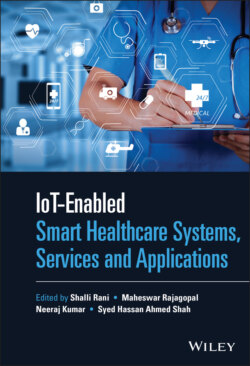Читать книгу IoT-enabled Smart Healthcare Systems, Services and Applications - Группа авторов - Страница 17
1.2.2 Internet of Things (IoT) in Smart Healthcare
ОглавлениеThe term “Things” in IoT in healthcare refers to the network of physical healthcare objects, meaning digital emergent technologies that connect the offline world through the Internet following some standard rules. Healthcare services are interconnected via smart sensors and devices. IoT has been conceived as one of the best solutions to face healthcare challenges and has therefore grabbed the attention of present research. It is supporting remote health monitoring making doctors capable of seeing their patients remotely and supervise them accordingly. IoT is using wireless sensor networks to communicate with doctors and outdoor patients for monitoring. Patients are having several smart types of equipment such as blood glucose monitors, pulse oximeters, blood pressure monitors, pedometers, and weighing scales [17]. With the help of these sensors, patients’ important data such as health history, biometric data, treatment history, patient reports, symptoms, and outcome measures that is needed to predict the fitness and future medical care is shared with the doctors. Therefore, it is providing great opportunities to utilize and adopt different monitoring methods for patient caretakers and medical staff. Its benefits cannot be neglected, as remote healthcare is beneficial for critical and noncritical patients as well. It has reduced the burden on hospitals from preventing day‐by‐day increase cases. IoT has also played a significant role in providing healthcare to patients living in rural areas that don’t have adequate access to it. For elder people who are at their homes for a longer period and are unable to make checkups, IoT has also emerged as a convenient resource for them. IoT systems are becoming expedient contributors in the healthcare industry [Impaired patients can be assisted by medical professionals without any waste of time by electronic communication by pointing toward various letters on their device and personal computers so they can call or even ask easily.
A famous term used in describing healthcare services provided through the IoT is “Telerehabilitation” and corresponds to the less expensive but the finest service. Regardless of any geographical barriers, it is the best solution for those patients who physically cannot attend the clinics and hospitals. It is most beneficial for older people because of its workability and cost effectiveness for managing their lifestyle and daily routine for doing therapy at home. A survey suggests that primary healthcare costs can be reduced up to 80 percent through telemedicine; this is one of the goals of WHO [18].
In the context of remote monitoring, smart devices allow us to change any rehabilitation tool in IoT devices. Parameters of human health such as body mass, body fat, or mass index can be measured by those devices connected to remote computers via Bluetooth by utilizing bioelectric impedance analysis () and carrying out periodic analyses of collected data. IoT is also playing a crucial role in cloud‐based intelligent healthcare services that keep a real‐time check on chronic diseases such as cancer. Health‐related data is stored in cloud repositories for future use. The newly emerged infrastructure of cloud computing can be accessed by anyone and anywhere at any time. It has empowered medical professionals to provide the best analysis and assistance for the treatment of disease. It uses principal component analysis (PCA) for characteristic evaluation and the KNN algorithm to monitor patients’ health statistics. KNN has a good performance to identify specific diseases, a most valuable and universally accessible healthcare service provided by IoT.
